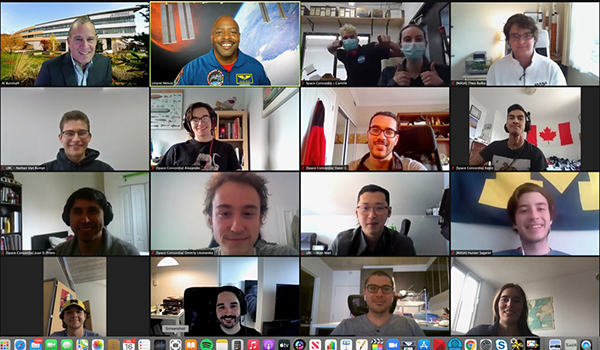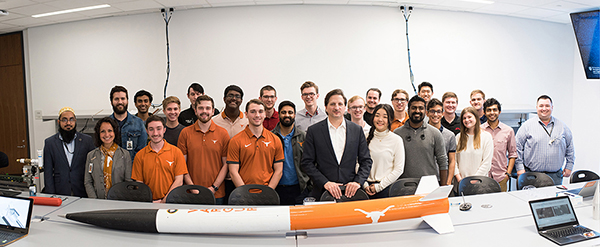Next-Gen Engineers: Eyes on the Sky
Student Competition Profile: Base 11 Space Challenge

The team designed and fabricated components for an industrial-scale rocket. Image courtesy of TREL.
Latest News
August 24, 2021
The Base 11 Space Challenge is a competition that motivates universities to bolster their rocketry programs and empower students to learn far more than liquid propulsion system theory by providing access to resources and to world-class experts.
Students acquire expertise in rocket safety and learn how to navigate flight regulations. Teams are encouraged to conduct outreach and provide mentorship to an array of community college and high school students to better develop the STEM (science, technology, engineering and mathematics) talent pipeline.
Members of the Texas Rocket Engineering Lab (TREL) at the University of Texas Cockrell School of Engineering designed and fabricated components for an industrial-scale rocket for their entry in the race to be the first team to design, build, launch and recover a liquid-fueled, single-stage rocket to an altitude of 100 km.
We spoke to Chase Holder of the University of Texas to learn more about their design. Holder is an aerospace engineering major and propulsion engineer for the TREL.
Digital Engineering: Can you provide an overview of the Base 11 Challenge?
Chase Holder: The Base 11 Space Challenge is an international engineering competition to be the first college organization to design, manufacture and launch the first liquid bipropellant rocket past the edge of space by the end of 2021. The Karman Line, the official 100 km high boundary of space, is over 30 times higher than the previous record for collegiate liquid rocketry.

For TREL, this will require over three years of work by more than 300 engineers, artists, communicators and business professionals to complete.
DE: Can you tell us about your rocket design and how it came to be?
Holder: The rocket was designed first and foremost with the mission of delivering a payload past the Karman line. The design of every subsystem has always ultimately been guided by this need. The size and mass of the rocket, the choice of fuels and the thrust of the engine all come from our desired payload mass.
At 30 feet tall and 2,600 pounds, this is one of the largest bipropellant collegiate rockets ever created and the engine, Havoc, delivers 3,500 pounds of thrust. The design of the engine was aided in large part by EOS because, historically, manufacturing rocket engine thrust chambers has been one of the most difficult and unreliable parts of the process. The EOS Additive Minds team provided us with 3D design and production support so we could create the engine with fewer pieces and more reliable hardware. We’re also working with EOS to produce the aerodynamic fins that will control the rocket in flight as they present more complex design options.
DE: How is adopting technological innovation linked to the program?
Holder: The use of additive manufacturing in rocket engines is a recent development that allows us, even as a small entity within the space of rocket propulsion, to participate and even add to this very exciting field. New materials, manufacturing processes and design techniques are being developed daily for engines now thanks to direct metal laser sintering. We have been able to take full advantage of this in our chamber and cooling channel design by using the EOS M400 to manufacture the components of the engine.
By using additive manufacturing techniques, we can have faster design iterations with testing coupons and full-scale designs, ensure quality control at the most stringent aerospace standards and make use of cutting-edge copper alloys that are less expensive and can handle the heat of our engine. Through additive manufacturing, we will be able to design the most advanced collegiate rocket ever built and break down barriers to space for people of all backgrounds.
Subscribe to our FREE magazine, FREE email newsletters or both!
Latest News
About the Author
Jim Romeo is a freelance writer based in Chesapeake, VA. Send e-mail about this article to [email protected].
Follow DE





